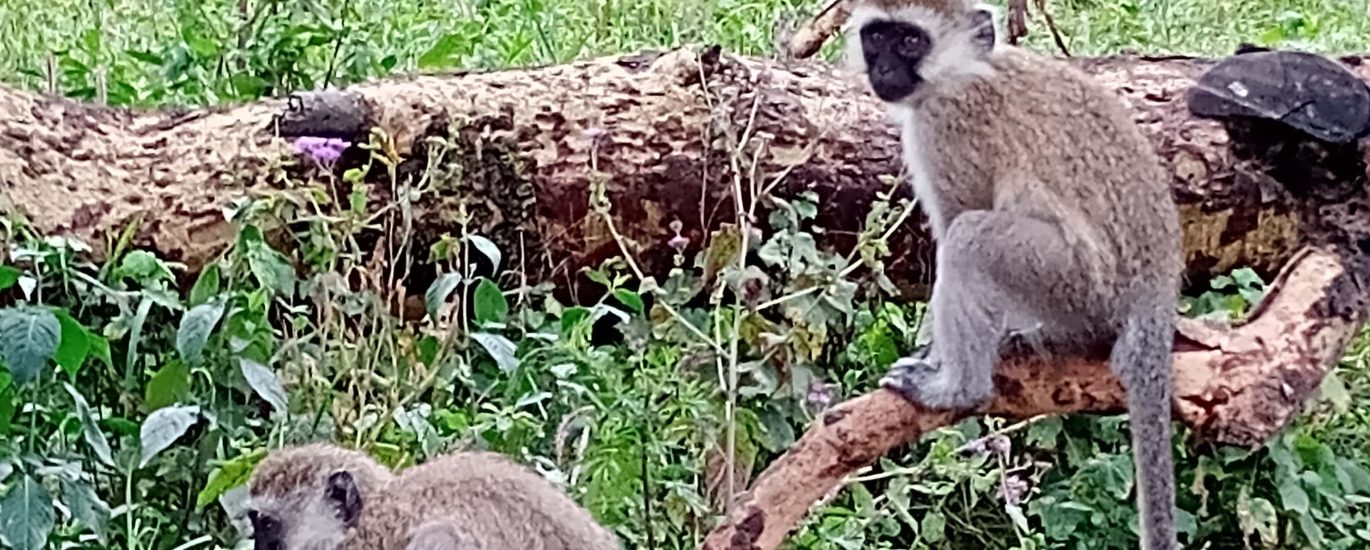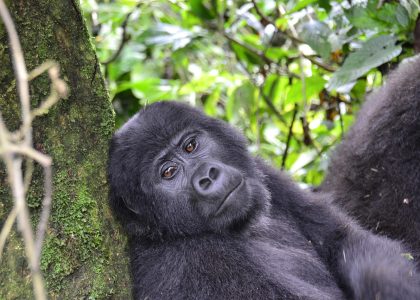In the third edition of our Wazimba Travel Uganda series, we venture beyond mountain gorillas to explore Uganda’s extraordinary primate diversity. Uganda hosts more primate species than any other East African country, with over 20 different species ranging from our closest living relatives—chimpanzees—to rare endemic monkeys found nowhere else on Earth. This remarkable primate kingdom offers visitors multiple opportunities for intimate wildlife encounters while supporting crucial research and conservation efforts.
Chimpanzees: Our Closest Living Relatives
Chimpanzees share 98.8% of human DNA and display complex behaviors that continue to fascinate researchers and visitors alike. Uganda protects the world’s largest population of chimpanzees, with over 5,000 individuals distributed across multiple forests and national parks. These intelligent apes live in large communities of 50-120 individuals, using sophisticated tools, communicating through complex vocalizations, and displaying distinct cultural behaviors that vary between different groups.
Kibale National Park: The Primate Capital of the World
Kibale National Park in western Uganda has earned its reputation as the “Primate Capital of the World” by protecting 13 different primate species within its 795 square kilometers of tropical rainforest. The park’s crown jewel is its population of over 1,500 chimpanzees—the highest density anywhere in East Africa.
The Kibale Chimpanzee Experience
Kibale offers two distinct chimpanzee encounters:
Standard Chimpanzee Tracking: Daily departures at 8 AM and 2 PM take visitors into the forest with experienced guides to locate one of four habituated chimpanzee communities. Success rates exceed 95%, making Kibale the most reliable destination for chimpanzee encounters in Africa. Once located, visitors spend one hour observing these remarkable apes as they feed, play, groom, and interact within their complex social hierarchy.
Chimpanzee Habituation Experience: This full-day adventure allows visitors to accompany researchers working with semi-habituated chimpanzee groups. Starting at dawn, participants follow chimpanzees from their sleeping nests through their daily activities until they construct evening nests. This intensive experience provides deeper insights into chimpanzee behavior and research methodologies while contributing directly to ongoing scientific studies.
Beyond Chimpanzees: Kibale’s Primate Diversity
Kibale’s primate wealth extends far beyond chimpanzees:
Red Colobus Monkeys: These endangered primates, with their distinctive rust-colored fur and social behaviors, live in large troops that often associate with other monkey species for protection and foraging advantages.
L’Hoest’s Monkeys: Endemic to the Albertine Rift region, these striking monkeys with white “beards” and dark faces represent one of Africa’s most localized primate species.
Blue Monkeys: Despite their name, these grey-blue primates display remarkable intelligence and complex social structures, often serving as sentinels for mixed-species monkey troops.
Red-tailed Monkeys: Easily identified by their copper-red tails and white nose spots, these agile primates excel at rapid movement through the forest canopy.
Black-and-white Colobus: These spectacular monkeys, with their flowing white mantles, represent one of Africa’s most photogenic primate species.
Wazimba Travel Tips for Kibale:
- Morning tracking offers better chimpanzee activity and cooler temperatures
- The habituation experience requires good fitness for 6-8 hours of forest walking
- Bring a small flashlight for early morning starts and dense forest conditions
- Waterproof camera protection is essential in humid forest conditions
- Book habituation experiences well in advance—only 4 visitors allowed per day
Budongo Forest: Chimpanzees Among Ancient Mahoganies
Budongo Forest Reserve, within Murchison Falls National Park, protects Uganda’s largest remaining natural forest and approximately 600 chimpanzees. This ancient forest, dominated by towering mahogany trees, provides a distinctly different chimpanzee tracking experience from Kibale’s denser vegetation.
The Budongo Advantage
Budongo’s more open forest structure often provides better visibility for chimpanzee observation and photography. The forest’s mature trees create cathedral-like spaces where chimpanzee calls echo dramatically, adding an almost mystical quality to tracking experiences.
Kaniyo Pabidi: This section of Budongo offers the most developed chimpanzee tracking program, with three habituated communities providing excellent success rates for visitor encounters.
Research Connection: Budongo hosts ongoing chimpanzee research programs, offering visitors opportunities to learn about current scientific discoveries while supporting conservation through tourism revenue.
Additional Budongo Primates
- Olive Baboons: Large troops with complex social hierarchies
- Vervet Monkeys: Intelligent and adaptable primates with distinct alarm calls
- Red-tailed Monkeys: Agile canopy specialists
- Blue Monkeys: Social species often found in mixed-species groups
Wazimba Travel Tips for Budongo:
- Combine chimpanzee tracking with Murchison Falls game drives for comprehensive experiences
- The forest can be muddy year-round—waterproof boots essential
- Early morning tracking avoids afternoon heat and provides better chimpanzee activity
- Longer drives from accommodation make this ideal for multi-day Murchison itineraries
Queen Elizabeth National Park: Kyambura Gorge Chimpanzees
The Kyambura Gorge, known as the “Valley of Apes,” provides one of Uganda’s most dramatic chimpanzee tracking settings. This 100-meter-deep forested gorge cuts through Queen Elizabeth National Park’s savannah landscape, creating a unique ecosystem that supports an isolated chimpanzee population.
The Kyambura Experience
Kyambura’s chimpanzee tracking involves descending into the spectacular gorge through dense vegetation to reach the forest floor where approximately 30 chimpanzees live in isolation from other populations. This unique setting creates both opportunities and challenges:
Scenic Drama: The gorge’s steep walls and river system create stunning landscapes that provide exceptional photography opportunities beyond the chimpanzees themselves.
Challenging Terrain: The steep descent and ascent require reasonable fitness levels, but the unique experience rewards the effort with memories unlike any other chimpanzee encounter.
Conservation Importance: This isolated population faces particular conservation challenges, making visitor support especially crucial for their long-term survival.
Wazimba Travel Tips for Kyambura:
- Success rates are lower than Kibale or Budongo due to the smaller population
- The experience is more about the dramatic setting than guaranteed chimpanzee sightings
- Combine with Queen Elizabeth game drives for comprehensive park experiences
- Strong hiking boots essential for steep gorge terrain
Mgahinga’s Golden Monkeys: Endangered Alpine Specialists
Mgahinga Gorilla National Park protects one of Africa’s most endangered and distinctive primate species—the golden monkey. These stunning primates, found only in the Virunga volcanic region, display brilliant golden fur that glows in filtered forest sunlight.
Golden Monkey Tracking
Golden monkey tracking provides an excellent complement to gorilla trekking with several advantages:
Less Physical Demand: Golden monkeys inhabit more accessible terrain than mountain gorillas, making tracking suitable for visitors with moderate fitness levels.
Playful Behavior: These highly social primates display entertaining behaviors including acrobatic leaps, social grooming, and curious interactions with visitors.
Photography Opportunities: Golden monkeys’ tolerance of human presence and active daytime behaviors create excellent conditions for wildlife photography.
Conservation Impact: Tourism revenue directly supports golden monkey conservation programs and habitat protection in the Virunga region.
Wazimba Travel Tips for Golden Monkeys:
- Combine with gorilla trekking for maximum primate experiences
- Morning tracking offers better monkey activity and lighting conditions
- Bring telephoto lens for close-up photography without disturbing animals
- Weather can change rapidly—pack layers for varying conditions
Specialized Primate Experiences
Semuliki National Park: Unique Forest Primates
Semuliki National Park, Uganda’s extension of the Congo Basin forest, hosts primate species found nowhere else in East Africa:
De Brazza’s Monkeys: These elusive primates with distinctive white beards require patience and expert guides to locate in dense forest vegetation.
Spot-nosed Guenons: Rare forest monkeys that represent the easternmost extent of their range.
Mabira Forest: Accessible Primate Diversity
Located between Kampala and Jinja, Mabira Forest provides easily accessible primate experiences:
Red-tailed Monkeys: Large populations in relatively open forest Blue Monkeys: Social groups often encountered along forest trails Vervet Monkeys: Adaptable species thriving in forest edge environments
Mount Elgon: Highland Primate Communities
Mount Elgon’s diverse elevation zones support several primate species:
Blue Monkeys: High-altitude populations adapted to cooler conditions Vervet Monkeys: Lower elevation communities Olive Baboons: Large troops utilizing forest and savannah interfaces
Primate Research and Conservation
Uganda’s primate populations benefit from extensive research programs that visitor fees help support:
Kibale Chimpanzee Project
This long-term research program, ongoing since 1987, has revolutionized understanding of chimpanzee behavior, ecology, and conservation needs. Visitor participation through tracking fees and habituation experiences directly funds:
- Behavioral studies revealing chimpanzee culture and intelligence
- Health monitoring programs protecting both chimpanzees and human communities
- Habitat protection initiatives ensuring long-term survival
- Community education programs building local conservation support
Golden Monkey Conservation Program
Research on golden monkeys in the Virunga region focuses on:
- Population monitoring across Rwanda, Uganda, and Democratic Republic of Congo
- Habitat restoration in degraded forest areas
- Human-wildlife conflict mitigation strategies
- Alternative livelihood programs for local communities
Community-Based Conservation
Uganda’s primate conservation success relies heavily on community involvement:
Revenue Sharing: 20% of tracking fees goes directly to local communities for development projects, creating economic incentives for forest protection.
Employment Opportunities: Primate tourism provides jobs for guides, porters, lodge staff, and craft makers, offering alternatives to forest exploitation.
Education Programs: Schools near primate habitats receive conservation education programs that build understanding and support for wildlife protection.
Ethical Primate Tourism Guidelines
Responsible primate encounters require strict adherence to guidelines protecting both animals and visitors:
Health Protocols
- Visitors showing illness symptoms cannot participate in tracking
- Maintain minimum 7-meter distance from all primates
- Wear face masks when recommended by guides
- Follow sanitization procedures before forest entry
Behavioral Guidelines
- Keep voices low and movements slow around primates
- Avoid direct eye contact with dominant individuals
- Never attempt to touch or feed wild primates
- Follow guide instructions immediately and without question
- No flash photography—it can startle and stress animals
Conservation Ethics
- Choose operators committed to conservation and community benefit
- Respect local customs and community guidelines
- Purchase local crafts and services to support community economies
- Learn about conservation challenges and share knowledge after returning home
Planning Your Primate Adventure
Multi-Park Primate Itineraries
Wazimba Travel specializes in creating comprehensive primate experiences:
5-Day Primate Focus: Combine Kibale chimpanzees with Queen Elizabeth Kyambura tracking and Mgahinga golden monkeys
7-Day Complete Primate Safari: Add Bwindi gorillas to create Uganda’s ultimate primate experience
10-Day Primate Research Adventure: Include habituation experiences and research center visits for deeper scientific engagement
Seasonal Considerations
Dry Seasons (June-August, December-February):
- Easier forest access and tracking conditions
- Better road conditions to remote parks
- Higher accommodation rates and booking competition
Wet Seasons (March-May, September-November):
- Lush forest vegetation ideal for photography
- More active primate behavior due to abundant food
- Lower accommodation rates and better availability
What to Pack for Primate Tracking
Essential Gear:
- Lightweight, long-sleeved shirts and pants for forest protection
- Waterproof hiking boots with good grip
- Rain jacket and pants for tropical downpours
- Gardening gloves for gripping vegetation
- Small daypack for water and snacks
Photography Equipment:
- Camera with telephoto lens (200mm minimum recommended)
- Extra batteries and memory cards
- Waterproof camera protection
- Portable phone charger for long days
Wazimba Travel Primate Packages
Our local expertise ensures exceptional primate experiences:
Expert Guides: Our trained primate specialists provide scientific context and maximize wildlife encounters
Seamless Logistics: We handle permits, transportation, and accommodation across multiple parks
Research Connections: Our partnerships with research organizations provide exclusive insights into ongoing scientific work
Community Integration: We ensure your visit benefits local communities through responsible tourism practices
The Primate Connection
Uganda’s remarkable primate diversity offers visitors unique opportunities to connect with our closest evolutionary relatives while supporting crucial conservation efforts. From the intelligence of chimpanzees to the playful antics of golden monkeys, these encounters provide profound insights into the natural world and our place within it.
As your local East African tour operator, Wazimba Travel creates primate experiences that combine exceptional wildlife encounters with meaningful conservation impact. Our deep knowledge of Uganda’s forests, research programs, and local communities ensures your primate adventure exceeds expectations while contributing positively to wildlife protection.
In our next article, we’ll explore Uganda’s magnificent waterways, from the source of the White Nile in Jinja to the thunderous Murchison Falls, where adventure sports meet cultural heritage in the Pearl of Africa’s aquatic playground.
Ready to meet Uganda’s incredible primates? Contact the Wazimba Travel team to design your perfect primate paradise adventure in the forests of Uganda.






